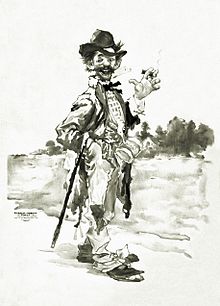
A tramp is a long-term homeless person who travels from place to place as a vagrant, traditionally walking all year round.

A tramp is a long-term homeless person who travels from place to place as a vagrant, traditionally walking all year round.
Tramp is derived from a Middle English verb meaning to "walk with heavy footsteps" (cf. modern English trample) and "to go hiking".
In Britain, the term was widely used to refer to vagrants in the early Victorian period. The social reporter Henry Mayhew refers to it in his writings of the 1840s and 1850s. By 1850, the word was well established. In that year, Mayhew described "the different kinds of vagrants or tramps" to be found in Britain, along with the "different trampers' houses in London or the country". He distinguished several types of tramps, ranging from young people fleeing from abusive families, through to people who made their living as wandering beggars and prostitutes. [1]
In the United States, the word became frequently used during the American Civil War, to describe the widely shared experience of undertaking long marches, often with heavy packs. Use of the word as a noun is thought to have begun shortly after the war. A few veterans had developed a liking for the "call of the road". Others may have been too traumatised by war time experience to return to settled life. [2]
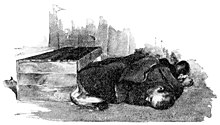
Wanderers have existed since ancient times. The modern concept of the "tramp" emerges with the expansion of industrial towns in the early nineteenth century, with the consequent increase in migrant labor and pressure on housing. The common lodging house or "doss house" developed to accommodate transients. Urbanisation also led to an increase in forms of highly marginalized casual labor. Mayhew identifies the problem of "tramping" as a particular product of the economic crisis of the 1840s known as the Hungry Forties. John Burnett argues that in earlier periods of economic stability "tramping" involved a wandering existence, moving from job to job which was a cheap way of experiencing adventures beyond the "boredom and bondage of village life". [3]
The number of transient homeless people increased markedly in the U.S. after the industrial recession of the early 1870s. Initially, the term "tramp" had a broad meaning, and was often used to refer to migrant workers who were looking for permanent work and lodgings. Later the term acquired a narrower meaning, to refer only to those who prefer the transient way of life. [2] Writing in 1877 Allan Pinkerton said: [4]
The tramp has always existed in some form or other, and he will continue on his wanderings until the end of time; but there is no question that he has come into public notice, particularly in America, to a greater extent during the present decade than ever before.
From 1896 to the last issue in 1953, the cover page of the British comic Illustrated Chips featured a comic strip of the tramps Weary Willie and Tired Tim, with its readers including a young Charlie Chaplin (who would become famous as the Tramp). [5]
Author Bart Kennedy, a self-described tramp of 1900 America, once said "I listen to the tramp, tramp of my feet, and wonder where I was going, and why I was going." [6] [7] John Sutherland (1989) said that Kennedy "is one of the early advocates of 'tramping', as the source of literary inspiration." [7]
The tramp became a character trope in vaudeville performance in the late 19th century in the United States. Lew Bloom claimed he was "the first stage tramp in the business". [8]
Perhaps because female tramps were often regarded as prostitutes, in the United States the term "tramp" came to refer to a promiscuous woman. However, this is not a global usage. [9] According to Australian linguist Kate Burridge, the term shifted towards this meaning in the 1920s, having previously predominantly referred to men, it followed the path of other similar gender neutral words (such as "slag") to having specific reference to female sexual laxity. [10]
The word is also used, with ambiguous irony, in the classic 1937 Rodgers and Hart song "The Lady Is a Tramp", which is about a wealthy member of New York high society who chooses a vagabond life in "hobohemia". [11] Other songs with implicit or explicit reference to this usage include The Son of Hickory Holler's Tramp and Gypsys, Tramps & Thieves .
The US State of Mississippi, until 2018, [12] had a specific definition for "tramps", which was a criminal offense: [13]
Any male person over 16 years of age, and not blind, who shall go about from place to place begging and asking subsistence by charity, and all who stroll over the country without lawful occasion, and can give no account of their conduct consistent with good citizenship, shall be held to be tramps. Every person, on conviction of being a tramp, shall be punished by a fine of not more than $50, or imprisonment in the county jail not more than one month, or both.
In French, "clochard" is a term for the homeless, especially in French cities. [14] The term is often associated with the romanticizing image of a person who has given up his bourgeois existence for a free life under the Seine bridges in Paris. [15]

A clown is a person who performs comedy and arts in a state of open-mindedness using physical comedy, typically while wearing distinct makeup or costuming and reversing folkway-norms. The art of performing as a clown is known as clowning or buffoonery, and the term "clown" may be used synonymously with predecessors like jester, buffoon, joker, fool, or harlequin. Clowns have a diverse tradition with significant variations in costume and performance. The most recognisable clowns are those that commonly perform in the circus, characterized by colorful wigs, red noses, and oversized shoes. However, clowns have also played roles in theater and folklore, like the court jesters of the Middle Ages and the jesters and ritual clowns of various indigenous cultures. Their performances can elicit a range of emotions, from humor and laughter to fear and discomfort, reflecting complex societal and psychological dimensions. Through the centuries, clowns have continued to play significant roles in society, evolving alongside changing cultural norms and artistic expressions.

A hobo is a migrant worker in the United States. Hoboes, tramps, and bums are generally regarded as related, but distinct: a hobo travels and is willing to work; a tramp travels, but avoids work if possible; a bum neither travels nor works.

The Tramp, also known as the Little Tramp, was English actor Charlie Chaplin's most memorable on-screen character and an icon in world cinema during the era of silent film. The Tramp is also the title of a silent film starring Chaplin, which Chaplin wrote and directed in 1915.

A soup kitchen, food kitchen, or meal center is a place where food is offered to the hungry usually for free or sometimes at a below-market price. Frequently located in lower-income neighborhoods, soup kitchens are often staffed by volunteer organizations, such as church or community groups. Soup kitchens sometimes obtain food from a food bank for free or at a low price, because they are considered a charity, which makes it easier for them to feed the many people who require their services.
Refusal of work is behavior in which a person refuses regular employment.
Faggot, often shortened to fag in American usage, is a term, usually considered a slur, used to refer to gay men. In American youth culture around the turn of the 21st century, its meaning extended as a broader reaching insult more related to masculinity and group power structure.
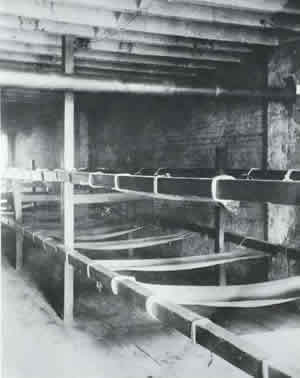
A flophouse or doss-house is a place that offers very low-cost lodging, providing space to sleep and minimal amenities.
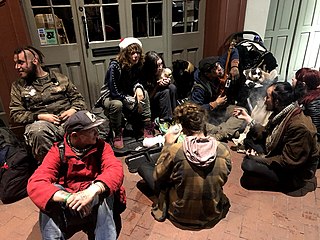
A gutter punk is a homeless or transient individual who displays a variety of specific lifestyle traits and characteristics that often, but not always, are associated with the punk subculture. Attributes may include unkempt dreadlocks, nose rings, Mohawk hairstyles, and tattooed faces. Gutter punks are sometimes referred to as "crusties","crust punks", "traveler kids", "traveling punks", "punk hobos or simply "travelers", among other terms. Some self-identified gutter punks may distinguish themselves from "crust punks" and "travellers", and vice versa; however, there is considerable overlap between the groups, and the terms are often used interchangeably.
Dromomania was a historical psychiatric diagnosis whose primary symptom was uncontrollable urge to walk or wander. Dromomania has also been referred to as traveling fugue. Non-clinically, the term has come to be used to describe a desire for frequent traveling or wanderlust.

Bergie is a term used for a subsection of homeless people in Cape Town, South Africa. The word originates from the Afrikaans berg meaning "mountain" – the term originally referred to the homeless people who sheltered in the forests of the slopes of Table Mountain. The synonymous term stroller typically refers to street children living a bergie lifestyle.

Mulligan stew, also known as hobo stew, is a type of stew said to have been prepared by American hobos in camps in the early 1900s.
Boodle is a slang term for money derived from the Dutch word 'boedel' meaning property or estate. Afrikaans inherited the word and its meaning from the Dutch, which probably accounts for its widespread use for money amongst English-speaking South Africans.

Leon Ray Livingston (1872–1944) was a famous hobo and author, travelling under the name "A-No.1" and often referred to as "The Rambler." He perfected the hobo symbols system, which let other hobos know where there are generous people, free food, jobs, vicious dogs, and so forth. He was not a poor man; he simply preferred a life of travelling the country by train to sitting at home. In his memoir The Ways of the Hobo, Livingston admitted that he was uneducated, but began his self-education at the age of 35.
Wobbly lingo is a collection of technical language, jargon, and historic slang used by the Industrial Workers of the World, known as the Wobblies, for more than a century. Many Wobbly terms derive from or are coextensive with hobo expressions used through the 1940s.
A tramp is a long-term homeless person who travels from place to place as an itinerant vagrant, traditionally walking or hiking.

Vagrancy is the condition of wandering homelessness without regular employment or income. Vagrants usually live in poverty and support themselves by travelling while engaging in begging, scavenging, or petty theft. Historically, vagrancy in Western societies was associated with petty crime, begging and lawlessness, and punishable by law with forced labor, military service, imprisonment, or confinement to dedicated labor houses.
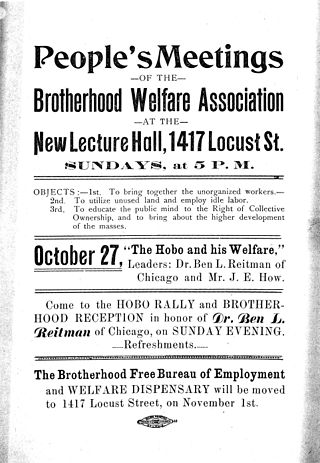
The International Brotherhood Welfare Association (IBWA) was a mutual aid society for hobos founded in 1905–1906. It was the second largest after the Industrial Workers of the World (IWW). It was started by James Eads How who had inherited a fortune but chose to live a hobo life. IBWA was less radical than the IWW, focusing on education and cooperation rather than direct political action. It published the Hobo News, distributed through street sellers. The IBWA was centered in the midwest and had locals in about twenty cities including Baltimore, Buffalo, Philadelphia and San Francisco. The centers, called "Hobo Colleges," offered lodging, hot meals and education. They also became important meeting places for migrant workers during the winter months.

James Eads How (1874–1930) was an American organizer of the hobo community in the early 20th century. He was heir of a wealthy St. Louis family but chose to live as a hobo and to help the homeless migrant workers. The newspapers often referred to him as the "Millionaire Hobo".
The National Hobo Association is an organization for enthusiasts of the hobo lifestyle, founded in Los Angeles as part of a "hobo revival" in the US in the late 1970s and during the Reagan administration. It was last headquartered in Nisswa, Minnesota.